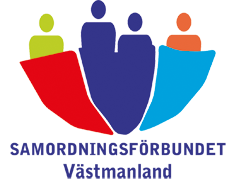Documentation of the workshop –
A Solution Focused Approach to Severe Trauma and Stress Recovery with John Henden
Target group for this workshop:
For those who have a basic competence, already, in Solution Focused working methods. Also, it is suitable for those treating people with PTSD; and, for those who meet people with severe trauma and stress, regardless of its cause, in various contexts in everyday life. The workshop provides practical tools which will increase confidence in participants’ own ability to converse with – and be helpful to – people who have suffered severe trauma and stress.
Lecturer: John Henden
Introduction


Workshop Aims
The purpose of this workshop is to provide attendees with:
- A greater understanding of this important area of work.
- Increased confidence in working with this group of service users.
- An appreciation of the importance for service users to move through the 3 transitional stages of survival.
- A range of tools and techniques for working with trauma and/or stress.
Hopes and Expectations
Answer the following question: ”By the end of today, how will I know this workshop has been useful to me?”

Intended learning outcomes/workshop objectives
At the end of the workshop, attendees will be able to:
- Demonstrate an increased understanding of severe trauma and/or stress
- Describe the characteristics of the victimhood, survivor hood and living life to the full
- Describe the basic SFBT tools and techniques used with this group of service users
(SFBT=Solution Focused Brief Therapy) - Use a variety of specialised tools and techniques for helping survivors move further towards their thriving self
- List the main points service users have made about how best workers can be helpful
- Name the pitfalls when working with severe trauma and/or stress survivors
- Highlight the most helpful and useful questions to ask survivors
- Feel more confident in their work with a wide range of service users who have experienced severe trauma and/or stress
Scaling confidence

On a scale of 1 – 10, how confident are you right now, generally, in working with survivors of severe trauma and stress?
A) How come it is Y and not X?
B) What would you have to do, over the next month or two, to move up just half a point?

Some fundamental principles, assumptions and beliefs of solution focused working
- The helper-helpee relationship is paramount.
- Generally, people are good at constructing solutions to most of the problems of daily living.
- ”If it ain’t broke, don’t fix it.”
- ”If it works, do more of it.”
- When people get stuck, it is usually because they are continuing to do what does not work – ”So, do something different…”.
- Change is happening all the time.
- There is no one ”right way” of looking at things.
- One small change in a person’s life can be amplified and can lead on to other changes being made.
- No ”problem” happens all the time. It is usually very helpful to find out exceptions to it or when it is less of a problem.
- It is important to stay solution focused and not solution forced.
The six main areas of concern
- Triggers
- Flashbacks
- Unwelcome (unwanted or intrusive) thoughts
- ”The lows”
- Sleep disturbance
- Living life to the full (thriving)
Exercise – Triggers for flashbacks
Sights, sounds, smells, tastes, bodily sensations, fears and anxieties may act as triggers for flashbacks; the content of intrusive thoughts in the future.

Exercise: Try to recall an incident that has affected you. Write down – sights, sounds, smells, tastes, bodily sensations, fears and anxieties – while the insident was happening. Share your stories with each other.
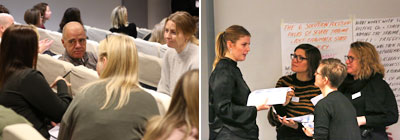
Sounds: silence, train brakes, children screaming, music at the time.
Smells: Smoke, smell of hospital.
Bodily sensations: Pressure on the breast, tension, increased heart racing.

Dual awareness exercise for dealing with flashbacks (Handout)
(Adapted from a protocol drawn up by Babette Rothschild)
It seems we have got two things going on here.
Right now, I am feeling (isolated/lonely/fearful/etc.) and I am sensing in my body… (3 or so things: i.e. heart racing, perspiring, tremulousness, etc…)
They are real sensations – that’s what I am experiencing now – because I am remembering the abuse/neglect/trauma/RTA/hold-up/explosion/combat/accident/etc.
However, at the same time, I am looking around where I am now here (the place/room where I am now) and:
I can see 5 things… I can hear 5 things… I can sense (feel, smell, taste) the following 5 things… And so I know, the incident/trauma/RTA/hold-up/explosion/accident/etc. is not happening now or any more.
Relationship flow chart


Here is a relationship flow chart that can be of help.
Exercise – Which can be the most powerful/helpful questions to ask?
We need to help them move on…

Helpful questions and statements from the worker (Handout)
- ”How would you like to use these sessions?”
- ”How much of the detail do you need to tell me before you are ready to move on?”
- ”Would it matter, if you healed yourself without remembering all that happened?”
- ”What strengths, qualities or special abilities did you call into play to survive that time/those incidents?”
- ”What have you done, up to now, not only to heal yourself, but to be living your life well?”
- ”What do you feel you need to tell me, in order for me to be most helpful to you?”
- ”What particular techniques do you use to counteract any intrusive thoughts you might be having?”
- ”On a scale of 1-10, where are you now, in terms of living life to the full?”
- ”What have you put into place so far?”
- ”What we know from this type of work, is that rarely, is the victim to blame at all.”
- ”It is quite common for people to feel guilty, but the guilt belongs with others.”
- ”What has been particularly helpful to you so far in expressing anger or other strong feelings?”
- ”What particular strengths, qualities, resources do you have that you have found to be helpful to you?”
- ”What would be the first (smallest) sign that things are getting better; that this is having less of an impact on your life?”
- ”What will you be doing differently when this (incident/trauma) is less of a problem in your life?”
- ”What will you be doing differently with your time?”
- ”What useful things will you be in the habit of saying to yourself?”
- ”What will you be thinking about (doing) instead of the thinking about the past?”
- ”Tell me about some times when the above is already happening to some (even small) extent.”
- ”What difference will the above healing changes make when they have been present in your life over an extended period of time?” (Weeks; days; months; years)
- ”What do you think that your (significant other) would say would be the first sign that things are getting better?” ”What do you think he/she will notice first?”
- ”What do you think your (friends; boss, etc.) will begin to notice about you as you heal/move forward even more?”
- Add more of your own…

John recommends us to watch:
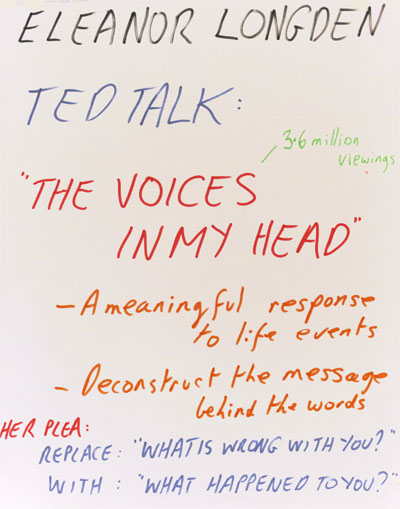

Techniques for triggers
”That was then, this is Now!!…”
(… and not anymore)
This technique is very powerful for arresting a trigger in its tracks. It ensures the locus of control remains with the service user and not with the trigger, which could easily lead into a flashback.
The secret is to practice saying, ”That was then, This is NOW!” on a regular basis, so that it is ready to use, in an instant. Service users should be encouraged to slow down their pace of speech, lower their voice-tone somewhat, and say the sentence forcefully, with the emphasis on the ”NOWWWW…!”
With this technique held in readiness – triggers – which are highly unpredictable – need not be feared; instead, they may be welcomed.

Film – Diaphramatic (7/11) breathing
- Very simple, yet very powerful technique.
- Easy to learn and apply.
- Good for gaining control over panic attacks.
- Teach it in the session and give it as homework, to practise.
Three stages of recovery
(With full acknowledgement to Yvonne Dolan)
- Victim
- Survivor
- Thriver (Living life to the Full)

Formula First Session Task – FFST (adapted for severe trauma survivors)
Purpose:
- Shifts the context from a problem focus to a solution orientation.
- Helps the work go more smoothly.
- Helps client achieve goals more quickly.
The following instruction, before the first meeting, helps the client to think Solution Focus before our meeting.

”Between now and when we meet, I would like you to notice what you have done/are doing already to put the memory of this incident away safely/make sense of it. Can you do this for me?”

Permission giving statements
Unexpressed negative emotions and/or unresolved/undeclared secrets from the past. The price not telling is psychological problems which hinders you from going through – victim – survivor – thriver. The following words can be of help.

- ”In all the years I have been doing this work, I have heard just about everything there is to hear about what can happen to people; and, what one person/people can do to another.”
- ”You may want to tell me what happened, either now or in the future. You may want to tell someone else. Also, you don’t have to tell anyone at all. All of these are okay…”

Victim, Survivor, Thriver –
The Three Stages (Handout)
Victim
- First stage of healing. First it is important for client to face the reality of the bad or unfortunate thing that happened.
- You can then acknowledge the negative feelings and emotions that might be around (grief, anger, sadness, disappointment, frustration, despair, hopelessness, helplessness, etc.)
- Allow yourself to experience these feelings and emotions: and express them safely.
- This is a vital part of healing + a valuable part of this stage.
- It is also important to recognise that what happened was not your fault, so you can let go of self blame and shame. (In the small number of cases where it was your fault, it is important for you to attribute only the correct proportion of blame to yourself. Then, it is important for you to consider in what ways constructively, you may make amends for what occurred).
- Find the courage to tell someone else what happened to you; this breaks down the isolation.
- As soon as the victim stage has been acknowledged and understood, you can move into the next stage – Survivor.
Survivor
- This begins when you understand you have lived beyond the traumatic or highly stressful experience/s that occurred.
- This stage reinforces the fact that it happened in the past.
- Then questions may be asked: ”How did I survive it?”; ”How did I do it?”; and, ”What strengths and resources did I use?”
- Acknowledgment of survivorhood involves:
- Developing an inventory of positive personality characteristics.
- Identifying and appreciating the internal strengths (knowledge, courage, spirituality and other positive aspects of self which have got you this far.
- Identifying external resources: mates, counsellor/therapist, minister, supportive family members, community support, etc. – at the time of the incident/s and afterwards
- At this stage, you will regain ability to function in everyday life: work, family time, household chores, time with mates, hobbies, community activities, etc.
- Once you have acknowledged you’ve survived – skills, strengths, qualities & resources – that have got you to survival and eventual wellbeing – move on – to thriving – move on to live life to the full/live as purposeful and meaningful life as possible
Thriver – Living life to the full
- This allows you more freedom than the earlier stages
- It allows you to experience a more compelling present and to contemplate a realistic and achievable future that is more vivid and fulfilling than your past
- It is now possible to enjoy life to the fullest, within any physical limitations you may have
- It is worthwhile to explore possibilities and dreams for the future you may be having right now
- It is now possible for you to express yourself in the most personally rewarding and creative ways available to you
- In this stage, your current experiences and relationships – may evoke increasingly a sense of immediacy, wonder and enhanced potential for future growth.
Source (Read more):
Victim – survivor – thriver (pdf)
Presuppositional language

The use of presuppositional language as a use of indirect communication was one of Milton Erickson’s major innovations.
Presuppositions are ways of talking that presume something without stating it directly: they are ”implicit, unconscious suggestions.”
Counsellors and therapists can use presuppositions to introduce change notions and expectations during the counselling or therapy session.
Some useful examples of pre-suppositional language are as follows:
- ”Which problem do you want to solve first, a or b?”
- ”When you have got through this time of difficulty, what other changes will you make in your life?”
- ”Tell me about a time when the problem was less of a problem.”
- When you have had similar difficulties in the past, what strategy/ies did you use to solve them?”
- Therapist: ”Tell me about a time when things were better.”
- Client: ”There have been none.”
- Therapist: ”So, you can’t remember a time right now.”
- ”Who will be the first to notice when you’ve cut back on your drinking?”
- ”When you are attending school on a more regular basis, what will be the main reasons for doing so?”
- ”How have you coped with things being worse?”
- ”When things are better again, how might you have got that to happen?”
Techniques for pleasant flashbacks
Sights, sounds, smells, tastes… can also be used for pleasant flashbacks.
- Dual awareness
- Purposely, bring on a pleasant flashback

Show the client that you can have control over flashbacks.
Survivor

Victim´s world – Small; compact
Survivor´s world – Pushing at the boundaries of their comfort zone
Thriver´s world – The sky is the limit
Techniques for intrusive/unwanted thoughts
- The ”Stop!” technique (+ replaying the video later) Let it go…
- Let it go… Let it go… (say this when intrusive thoughts occur.)
- Tackle ”the guilt trip”
- Survivor guilt is a common feature: ”It was all my fault…”
- ”If only…”
- ”I feel so guilty because he died and I survived”
- There are 2 strategies:
- ”It was not your fault…” – reality check
- ”You are not wholly to blame” %ages exercise:
– get a realistic %age of blame
– ”guilt shared, is more than halved”.
Example of the ”Stop!” Techniques


Dealing with ”the lows”
- The rainy day letter.
- Make contact with a nurturing friend.
- Maintain good exercise, diet, fluid intake and sleep pattern.
The Rainy Day Letter
(With full acknowledgement to Yvonne Dolan)
While some of life’s difficult passages are impossible to anticipate, thankfully, they are not impossible to prepare for; that is the purpose of the ”rainy day letter”.
This is a letter from you to you. It should be written not in a moment of despair, but in a moment of relative calm and well-being.
The Rainy Day Letter (pdf)
Exercise – Start your rainy day letter

The solution focused feelings tank

- A very visual tool.
- Especially good for healthy discharge of anger.
- May be used for the whole range of negative emotions.


Five positive ways to deal with anger
- Talk with co-worker or good friend.
- Write down the feelings in a diary or journal; writing ”as if” letters.
- Take energetic physical exercise: punch bags/cycling/fast walking/gym workouts/swimming/etc.
- Shout it out.
- Paint it or draw it (best for children?).
For second and subsequent sessions

- Elicit Positive Change: ”What’s better?”
- Reinforce the Change: ”How did you do that?”, ”How did you know how to do that?”
- Amplify the Change: ”What else is better?”, What else . . .?”, ”Who has noticed?”, ”What have they noticed?”
- Build on Improvement: ”What other changes might you make as a result of this happening?”, ”What will be your first small step?”, ”How will you know when you’ve got where you want to be?”

Eight key points to avoid re-traumatisation or re-victimisation – when clients disclose

- Show compassion and deep empathy.
- As the service user discloses:
acknowledge, validate and normalise all feelings and sensations expressed. - Ask strength-based questions, interrupting as appropriate whilst the client is disclosing, as follows:
- How did you cope at the time?
- What got you through all this?
- What most helped?
- How did you do that?
- How did you know how to do that?
- Looking back on what happened, in what ways has it made you a more determined and/or stronger person?
- Awful though it was, which aspects of surviving it have made you a better person?
- It is important to compliment sincerely, where appropriate, both as the service user is disclosing; and most importantly at the end of the session.
- Treat the content with care, respect and in a supportive manner.
- Value and affirm throughout, both verbally and non-verbally.
- Keep your own and your service user’s eyes on the treatment goals.
- Keep to the ”5 o’clock rule”.
The (most important) Thriver Stage

- Principle focus of client.
- Meaning and purpose; direction in life.
- Visualisation is important (e.g. Letter from the future).
- More freedom than at earlier stages.
- Real future possibilities and dreams can be explored.
- Allows more compelling presents to be experienced.
- Enjoy life to the full.
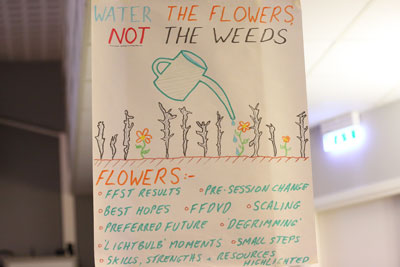
Thriving

- Living life to the Full
- Living the life you richly deserve
- Living the Authentic Life
- Living life as Full as Possible
The Letter from the Future
(With full acknowledgement to Yvonne Dolan)
How to use the letter from the future – pick a time in the future – it might be in 20 years time.
The purpose of dating the letter and writing it to someone you actually know is to strengthen the psychological realism of the letter for you on both an unconscious and conscious level. Imagine that in this future, you have resolved whatever problems that are troubling you at the present time. Describe what helped you resolve those problems.
Read more:
The Letter from the Future (pdf)
How to use The Letter from the Future (pdf)
Remembering…
”… only what is necessary in order to heal and feel relief; conducted in a manner that maximises the client’s sense of comfort, security and control, while retrieving and resolving memories of the abuse, neglect and/or trauma”.
The attendees – Scaling confidence
John´s last question in this workshop to the attendees – following up the workshop:
”On your scale of 1-10, how confident are you right now in working, generally, with survivors of severe trauma and stress?”
What number did you write down this morning? How many points up on the scale are you now?

How did you do that?
- Learned about tools and techniques.
- Learn from your stories.
- Beeing in a context with other discussing.
- The SF feelings tank will be useful.

Voices from the attendes
Some comments from three participants:
”Feels good – easy to understand John’s English.”
”This workshop will be useful even though we are not working directly with trauma patients.”
”Now we have a better understanding and feel more confident.”

Finally
We are all very grateful to John for sharing so much experience, many stories and valuable examples – this will really be helpful to us.
Thank you!
More from John Henden
Books
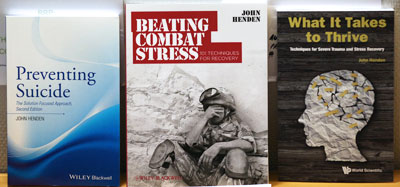
- Preventing Suicide: The Solution Focused Approach – Amazon
- Beating Combat Stress – Amazon
- What it Takes to Thrive – Amazon
The books are available at:
John Henden – Adlibris and John Henden – Amazon UK
Website:
John Henden Consultancy
Selected recommendations
- The Amygdala in Five Minutes. Joseph LeDoux (2012)- YouTube (5.38)
- The Emotional Brain. Joseph LeDoux (2013) – YouTube (53:57)
- TED – The voices in my head – Eleonor Longden (14:17)
More about John
John Henden is an international trainer, author, therapist and performance coach. For over 20 years, he worked within UK NHS mental health services firstly as a practitioner, then as a manager, during a time of rapid change. He delivers training courses from a broad portfolio; and, also provides organisations with personal coaching and mentoring services.
As a trainer, in adopting an action-learning approach, John has an energetic and captivating teaching style, which enables participants to remain both alert and involved throughout.


one of John´s books.
The Hosts

- Ann Åkerlund-Rilegård, Norra Västmanlands Samordningsförbund
- Hanna Stålarv, Norra Västmanlands Samordningsförbund
- Linda Anderfjäll, Samordningsförbundet Västra Mälardalen
- Ann-Kristin Ekman, Samordningsförbundet Västerås
- Sussan Öster, VITAL goodsolution
The day was financed by the three Samordningsförbunden in Västmanlands län.
Summary and photo:
Christina Wallnér, No WaIT AB
